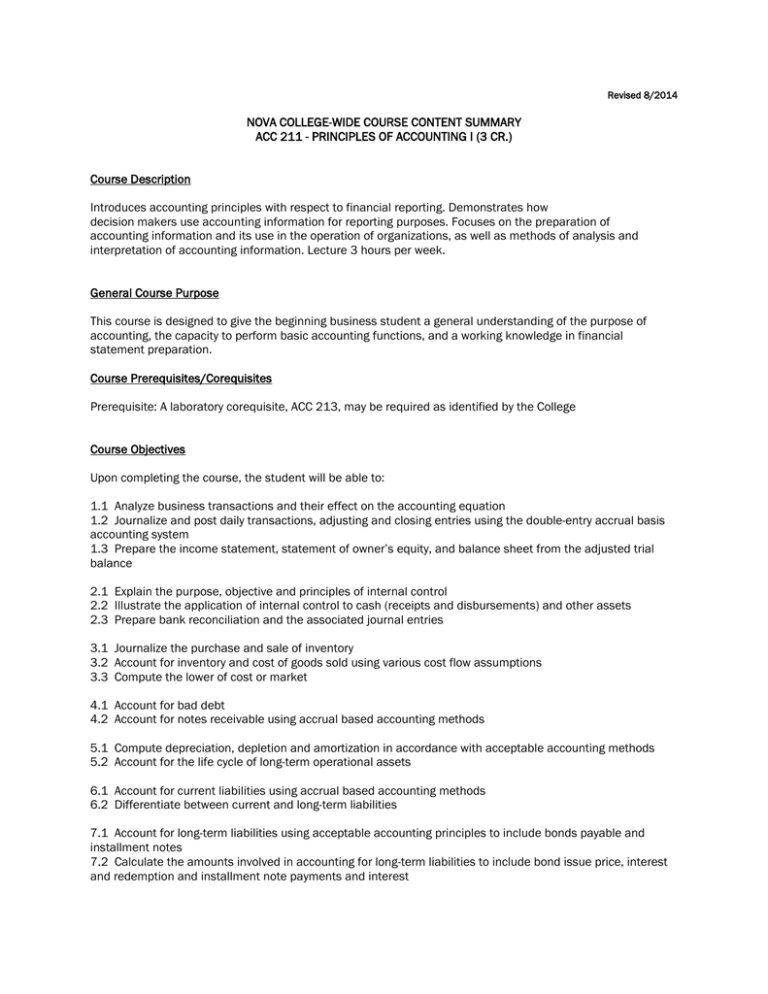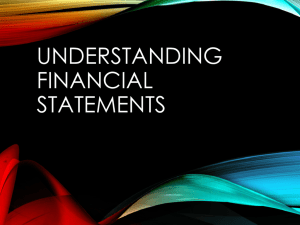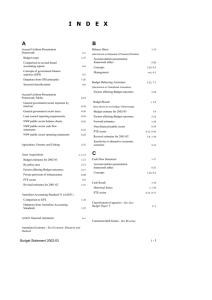NOVA COLLEGE-WIDE COURSE CONTENT SUMMARY Course Description
advertisement

Revised 8/2014 NOVA COLLEGE-WIDE COURSE CONTENT SUMMARY ACC 211 - PRINCIPLES OF ACCOUNTING I (3 CR.) Course Description Introduces accounting principles with respect to financial reporting. Demonstrates how decision makers use accounting information for reporting purposes. Focuses on the preparation of accounting information and its use in the operation of organizations, as well as methods of analysis and interpretation of accounting information. Lecture 3 hours per week. General Course Purpose This course is designed to give the beginning business student a general understanding of the purpose of accounting, the capacity to perform basic accounting functions, and a working knowledge in financial statement preparation. Course Prerequisites/Corequisites Prerequisite: A laboratory corequisite, ACC 213, may be required as identified by the College Course Objectives Upon completing the course, the student will be able to: 1.1 Analyze business transactions and their effect on the accounting equation 1.2 Journalize and post daily transactions, adjusting and closing entries using the double-entry accrual basis accounting system 1.3 Prepare the income statement, statement of owner’s equity, and balance sheet from the adjusted trial balance 2.1 Explain the purpose, objective and principles of internal control 2.2 Illustrate the application of internal control to cash (receipts and disbursements) and other assets 2.3 Prepare bank reconciliation and the associated journal entries 3.1 Journalize the purchase and sale of inventory 3.2 Account for inventory and cost of goods sold using various cost flow assumptions 3.3 Compute the lower of cost or market 4.1 Account for bad debt 4.2 Account for notes receivable using accrual based accounting methods 5.1 Compute depreciation, depletion and amortization in accordance with acceptable accounting methods 5.2 Account for the life cycle of long-term operational assets 6.1 Account for current liabilities using accrual based accounting methods 6.2 Differentiate between current and long-term liabilities 7.1 Account for long-term liabilities using acceptable accounting principles to include bonds payable and installment notes 7.2 Calculate the amounts involved in accounting for long-term liabilities to include bond issue price, interest and redemption and installment note payments and interest 8.1 Account for corporate transactions with stockholders to include issuance of stock, dividends, repurchase of stock and stock splits 8.2 Prepare a statement of retained earnings and a statement of stockholders’ equity 9.1 Differentiate between operating, investing and financing activities as well as noncash investing and financing transactions 9.2 Prepare the statement of cash flows 10.0 Analyze financial statements to assess the liquidity, efficiency, solvency, market prospects and profitability of businesses Optional SLOs (see Optional Topics) 11.1 Distinguish between different types of investments to include debt and other non-influential, influential and controlling interest ownership 11.2 Account for investment transactions using acceptable accounting methods 12.1 Calculate each partner’s share of net income or loss 12.2 Prepare a statement of partner’s capital and balance sheet 13.1 Compute the present value of $1 and the present value of an annuity 13.2 Explain the meaning of present value of $1 and the present value of an annuity Major Topics to be Included 1. Accounting Cycle 2. Cash and Internal Controls 3. Accounting for Merchandisers 4. Receivables 5. Long-Term Operational Assets 6. Current Liabilities 7. Long-term Liabilities 8. Corporations 9. Cash Flow Statement 10. Financial Statement Analysis Optional Topics to be Included 11. Investments 12. Partnerships 13. Time Value of Money





